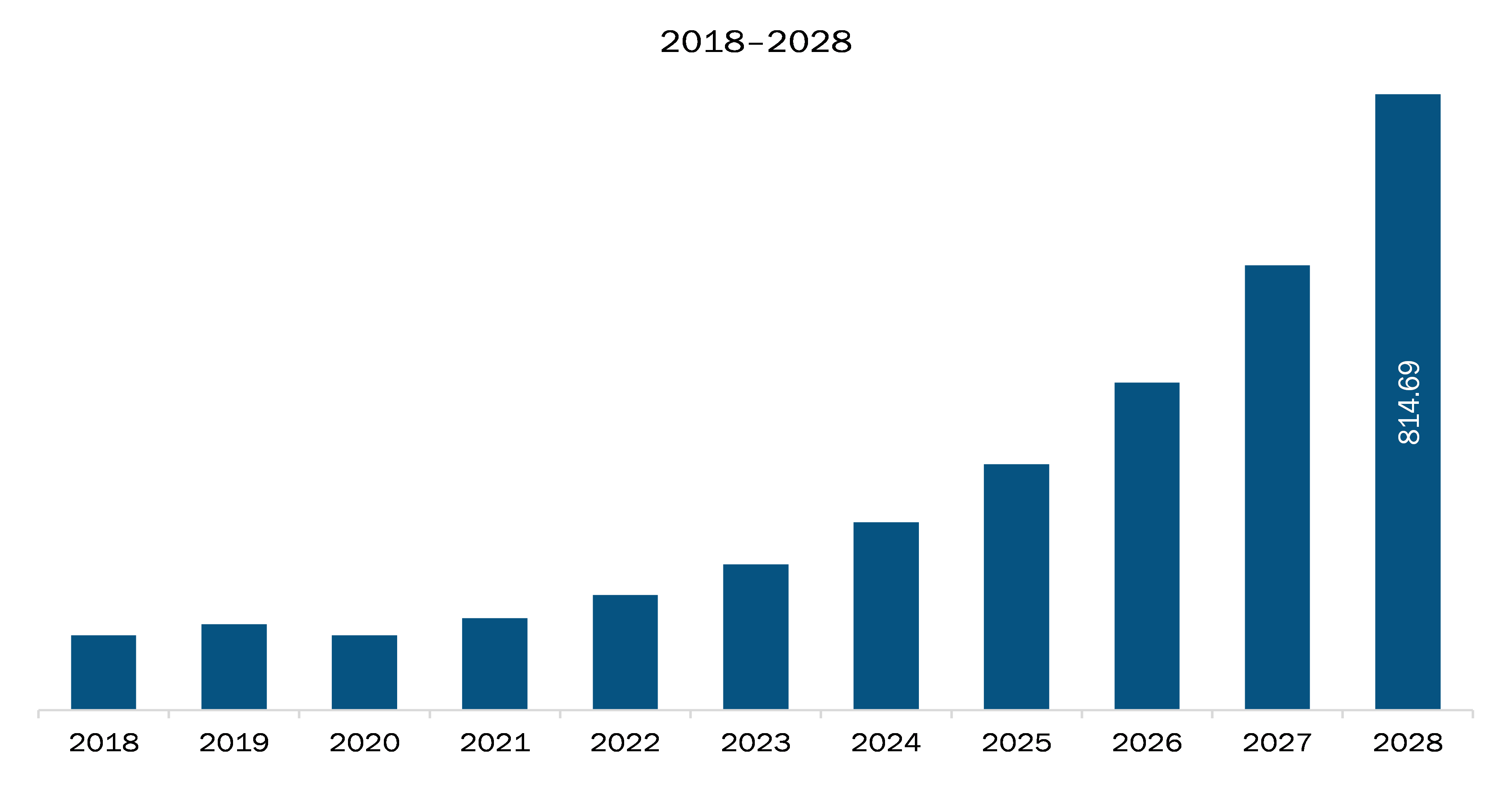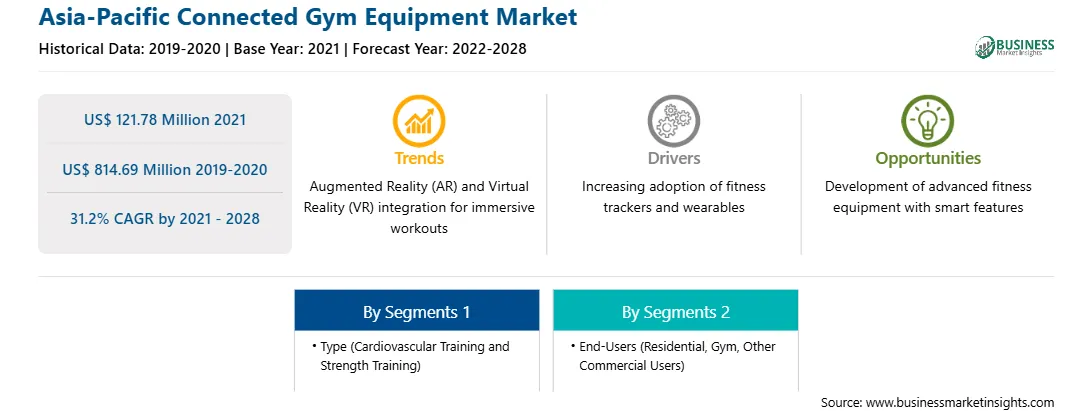The APAC Connected Gym Equipment market is further segmented into Australia, India, China, Japan, South Korea, and the Rest of APAC. Digital transformation is a new trend across the region's, due to the high digital transformation pace. This results in an increasing demand for innovative devices, such as connected gym equipment. Further, the growing awareness of advanced technology features is expected to boost the adoption of connected gym equipment’s. The regional governments are investing towards promoting the connected gym equipment market to further boost the public awareness about health and fitness and to encourage better health practices by reducing the issues of chronic diseases which are driving the market growth. Also, the flourishing young population and growing awareness is fueling the connected gym equipment market. Furthermore, the enhanced lifestyle of the people, the upsurge in non-renewable income, especially across the developing countries, offering immense growth potential for the market operating in the connected gym equipment market. Additionally, the increasing cases of chronic heart and arrears disease, due to the sedentary lifestyle of the individual. Thus, to counter this issue, the public and the governments are introducing several health awareness programs and programs to boost the connected gym equipment market.
In case of COVID-19, APAC is highly affected specially India. APAC is a region which comprises of many developing nations. This region is characterized by big industrial presence, great economic opportunities, and high population. All the mentioned factors make APAC a major region for the growth of various markets including connected gym equipment. The temporary shutdown of various manufacturing units and factories in many countries of this region is impacting the supply chains and negatively impacting the production, delivery schedules and sales of various products as well services. Most of the Asian countries are developing countries and hence the presence of connected gym equipment is majorly found in commercial applications like health clubs, gyms, and hotels only. Since these all places are either temporarily closed or operating with various restriction and limitations, a severe impact is observed on the procurement and production of connected gym equipment. Since disposable income in these countries is not that high, majority of population cannot easily afford residential connected gym equipment for exercise and physical activities. Additionally, the region is a global manufacturing hub with countries like Japan, China, India, and South Korea, which all lead the global manufacturing industry growth. Since last year, a negative impact has been observed in growth of the connected gym equipment market.

Strategic insights for the Asia-Pacific Connected Gym Equipment provides data-driven analysis of the industry landscape, including current trends, key players, and regional nuances. These insights offer actionable recommendations, enabling readers to differentiate themselves from competitors by identifying untapped segments or developing unique value propositions. Leveraging data analytics, these insights help industry players anticipate the market shifts, whether investors, manufacturers, or other stakeholders. A future-oriented perspective is essential, helping stakeholders anticipate market shifts and position themselves for long-term success in this dynamic region. Ultimately, effective strategic insights empower readers to make informed decisions that drive profitability and achieve their business objectives within the market.

| Report Attribute | Details |
|---|---|
| Market size in 2021 | US$ 121.78 Million |
| Market Size by 2028 | US$ 814.69 Million |
| Global CAGR (2021 - 2028) | 31.2% |
| Historical Data | 2019-2020 |
| Forecast period | 2022-2028 |
| Segments Covered |
By Type
|
| Regions and Countries Covered | Asia-Pacific
|
| Market leaders and key company profiles |
The geographic scope of the Asia-Pacific Connected Gym Equipment refers to the specific areas in which a business operates and competes. Understanding local distinctions, such as diverse consumer preferences (e.g., demand for specific plug types or battery backup durations), varying economic conditions, and regulatory environments, is crucial for tailoring strategies to specific markets. Businesses can expand their reach by identifying underserved areas or adapting their offerings to meet local demands. A clear market focus allows for more effective resource allocation, targeted marketing campaigns, and better positioning against local competitors, ultimately driving growth in those targeted areas.

The APAC connected gym equipment market is expected to grow from US$ 121.78 million in 2021 to US$ 814.69 million by 2028; it is estimated to grow at a CAGR of 31.2% from 2021 to 2028. Surging health concerns will escalate the market in coming years. Earlier, people did not have to take out dedicated time for exercise. Their daily routine was enough to burn those extra calories. Barring few jobs like product delivery, nursing, surgery, and some farming activities, almost all jobs in today’s time are moving towards sedentary work style. This is happening because automation is taking place in almost every walk of life. These all has given rise to insufficient physical activity among individuals. Insufficient physical activity in daily life is considered as one of the major risk factors for death all over the APAC region. Inadequate physical activity is a crucial risk factor involved with non-communicable diseases (NCDs) like cancer, diabetes, and cardiovascular diseases. It also invites unwanted obesity in many people at very young age. So, to manage the health properly, people are getting aware and conscious about indulging in daily physical activities. Gyming helps in reducing body weight, building bones and muscles, increasing energy levels, and improving skin health. Increase in monetary income allows the consumers to spend on gyming. Along with physical health, gyming also improve people’s mental health to a large extent. It helps in improving sleep quality and memory. It also helps in staying energetic and relaxed. Managing mental health is equally important for performing in today’s work life. So, the growing gyming activities will increase the demand of connect gym equipment, thereby driving the APAC connected gym equipment market.
In terms of type, the cardiovascular training segment accounted for the largest share of the APAC connected gym equipment market in 2020. In terms of end-users, the gym segment held a larger market share of the APAC connected gym equipment market in 2020.
A few major primary and secondary sources referred to for preparing this report on the APAC connected gym equipment market are company websites, annual reports, financial reports, national government documents, and statistical database, among others. Major companies listed in the report are Cybex International, Inc.; Johnson Health Tech; LES MILLS INTERNATIONAL LTD; Life Fitness; Nautilus, Inc.; and Technogym S.p.A.
The Asia-Pacific Connected Gym Equipment Market is valued at US$ 121.78 Million in 2021, it is projected to reach US$ 814.69 Million by 2028.
As per our report Asia-Pacific Connected Gym Equipment Market, the market size is valued at US$ 121.78 Million in 2021, projecting it to reach US$ 814.69 Million by 2028. This translates to a CAGR of approximately 31.2% during the forecast period.
The Asia-Pacific Connected Gym Equipment Market report typically cover these key segments-
The historic period, base year, and forecast period can vary slightly depending on the specific market research report. However, for the Asia-Pacific Connected Gym Equipment Market report:
The Asia-Pacific Connected Gym Equipment Market is populated by several key players, each contributing to its growth and innovation. Some of the major players include:
The Asia-Pacific Connected Gym Equipment Market report is valuable for diverse stakeholders, including:
Essentially, anyone involved in or considering involvement in the Asia-Pacific Connected Gym Equipment Market value chain can benefit from the information contained in a comprehensive market report.